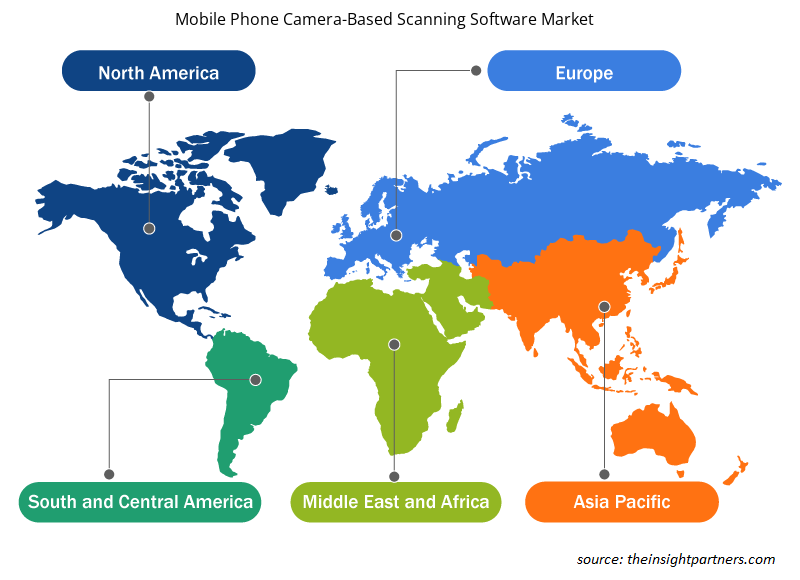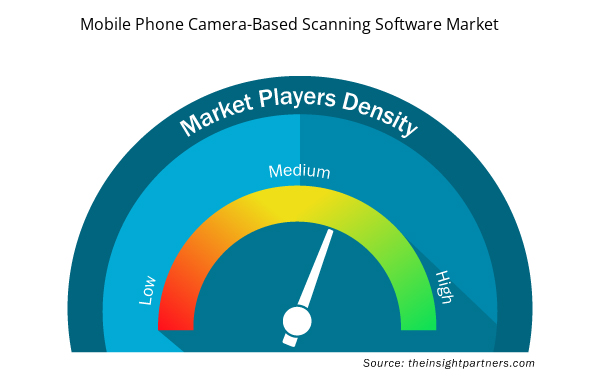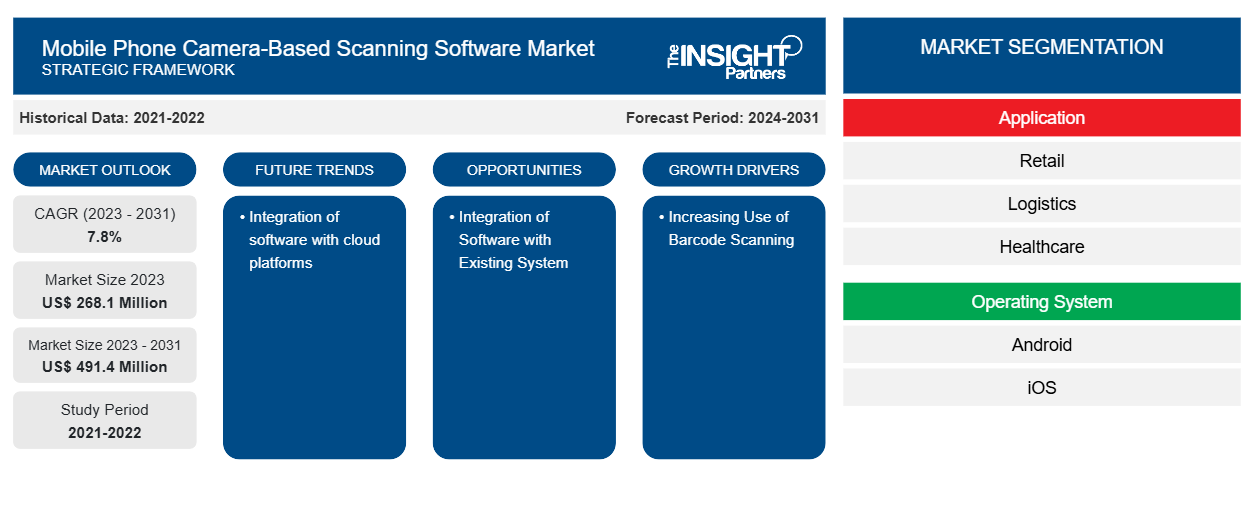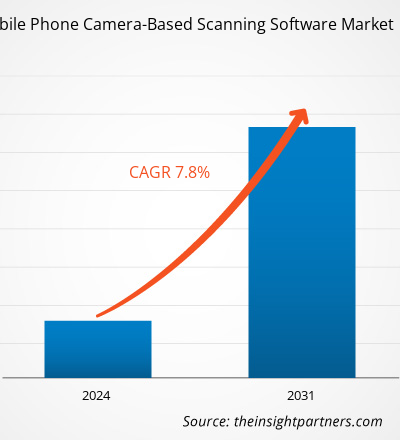预计到 2031 年,基于手机摄像头的扫描软件市场规模将从 2023 年的 2.681 亿美元增至 4.914 亿美元。预计 2023-2031 年期间该市场的复合年增长率将达到7.8 %。软件与云平台的集成可能仍是市场的主要趋势。
手机摄像头扫描软件市场分析
扫描软件有望改变企业的运营方式,与传统的硬件条形码扫描仪相比,它具有众多优势。通过采用基于软件的扫描解决方案,企业可以提高效率、提高准确性并获得宝贵的见解,最终实现增长和成功。条形码扫描软件已经彻底改变了包括零售业在内的各个行业,简化了库存管理、产品跟踪和结账流程。在物流领域,它可以自动收集数据、跟踪货物并优化仓库运营。在医疗保健领域,它可以增强患者识别、药物管理和医疗记录管理。
手机摄像头扫描软件市场概况
条码扫描软件使用软件算法来解码数码相机或移动设备收集的条码。与需要专业设备的硬件条码扫描仪不同,条码软件解决方案可以集成到当前设备和应用程序中,从而提供更大的灵活性并节省成本。扫描软件通常称为条码扫描仪 API,或简称为条码API。与传统的硬件条码扫描仪相比,条码扫描软件具有多种优势。它提供了灵活性,并且解决方案可以轻松调整以适应各种扫描场景和相机配置,使其适用于各种应用程序。该软件无需专用硬件,从而降低了前期成本。此外,扫描软件解决方案通常只需要很少的维护和更新,从而降低了长期成本。
定制此报告以满足您的需求
您可以免费定制任何报告,包括本报告的部分内容、国家级分析、Excel 数据包,以及为初创企业和大学提供优惠和折扣
- 获取此报告的关键市场趋势。这个免费样品将包括数据分析,从市场趋势到估计和预测。
基于手机摄像头的扫描软件市场驱动因素和机遇
条码扫描使用率不断提高,市场前景看好
依赖手动数据输入的公司、仓库和其他设施的人为错误率很高。手动输入数据的员工很可能会颠倒数字、跳过一行、误解数字或使用别人无法阅读的糟糕笔迹。另一方面,条形码大大降低了人为错误的可能性,几乎可以消除人为错误。条形码扫描比手动数据输入更高效、更可靠、更省时。努力降低库存持有成本的公司也可以从实施条形码程序中受益。条形码使公司能够实时更新库存,并提供即时、准确的更新,从而提供真实的库存数量。更准确的库存数量有助于提高效率,因为它们使公司能够确定更准确的交货时间、更准确的库存成本定义和更高的市场价格。因此,条形码的使用量增加,并推动了基于摄像头的条形码扫描软件的增长。
软件与现有系统的集成
基于手机摄像头的扫描软件提供了一系列超越传统条形码扫描的功能和能力,包括数据收集、处理和与现有系统或软件的集成。它们可以与中央数据库同步数据,与POS系统或库存管理软件通信,并以无线方式传输信息以确保实时更新和准确性。该软件可以定制或开发,以与现有系统无缝集成,如库存管理软件、销售点 ( POS ) 系统、客户关系管理 ( CRM ) 软件和企业资源规划 ( ERP ) 系统。这种兼容性使企业能够利用其现有的软件基础设施,最大限度地优化运营效率。因此,与现有系统的集成为市场的增长创造了机会。
手机摄像头扫描软件市场报告细分分析
有助于得出基于手机摄像头的扫描软件市场分析的关键部分是应用程序和操作系统。
- 根据应用,基于手机摄像头的扫描软件市场细分为零售、物流、医疗保健、酒店、邮政和其他。
- 就操作系统而言,市场分为 Android 和 iOS。
手机摄像头扫描软件市场份额(按地区)分析
基于手机摄像头的扫描软件市场报告的地理范围主要分为五个区域:北美、亚太地区、欧洲、中东和非洲以及南美和中美洲。北美是一个发达国家,拥有各种软件开发商和数字解决方案提供商。北美各地的企业都在采用软件和数字解决方案。智能手机技术的发展在各个地区都变得越来越复杂;越来越多的开发人员正在尝试提高智能手机的功能。其中一项功能是将摄像头技术不仅用作图像捕捉设备,还可以用作扫描仪替代设备来提高生产力。
基于手机摄像头的扫描软件市场区域洞察
Insight Partners 的分析师已详尽解释了预测期内影响手机摄像头扫描软件市场的区域趋势和因素。本节还讨论了手机摄像头扫描软件市场的各个部分和地理位置,包括北美、欧洲、亚太地区、中东和非洲以及南美和中美洲。

- 获取基于手机摄像头的扫描软件市场的区域特定数据
基于手机摄像头的扫描软件市场报告范围
| 报告属性 | 细节 |
|---|---|
| 2023 年的市场规模 | 2.681亿美元 |
| 2031 年市场规模 | 4.914亿美元 |
| 全球复合年增长率(2023 - 2031) | 7.8% |
| 史料 | 2021-2022 |
| 预测期 | 2024-2031 |
| 涵盖的领域 | 按应用
|
| 覆盖地区和国家 | 北美
|
| 市场领导者和主要公司简介 |
|
手机摄像头扫描软件市场参与者密度:了解其对业务动态的影响
手机摄像头扫描软件市场正在快速增长,这得益于终端用户需求的不断增长,这些需求源于消费者偏好的不断变化、技术进步以及对产品优势的认识不断提高等因素。随着需求的增加,企业正在扩大其产品范围,进行创新以满足消费者的需求,并利用新兴趋势,从而进一步推动市场增长。
市场参与者密度是指在特定市场或行业内运营的企业或公司的分布情况。它表明在给定市场空间中,相对于其规模或总市场价值,有多少竞争对手(市场参与者)存在。
在基于手机摄像头的扫描软件市场运营的主要公司有:
- 斯坎迪特
- RIOTEC 有限公司 co., Ltd.
- 格拉巴
- 马尔森科技有限公司 TECHNOLOGY CO., LTD
- 韩国科阿姆塔克
- 康耐视公司 Corporation
免责声明:上面列出的公司没有按照任何特定顺序排列。

- 获取基于手机摄像头的扫描软件市场顶级关键参与者概览
基于手机摄像头的扫描软件市场新闻和最新发展
通过收集一手和二手研究的定性和定量数据来评估基于手机摄像头的扫描软件市场,其中包括重要的公司出版物、协会数据和数据库。下面列出了基于手机摄像头的扫描软件市场的一些发展情况:
- Scandit 是一家移动计算机视觉和增强现实 (AR) 企业技术平台,该公司宣布,多承运商运输解决方案 Consignor 已将 Scandit 的条码扫描仪 SDK 集成到其新的 Scan App Pro 中,从而可以使用无与伦比的条码库进行快速可靠的扫描。(来源:Scandit.,2021 年 2 月), the enterprise technology platform for mobile computer vision and augmented reality (AR) has announced that Consignor, a multi-carrier shipping solution, has integrated Scandit's Barcode Scanner SDK into its new Scan App Pro, allowing for fast and reliable scanning with an unrivaled barcode library. (Source: Scandit., February 2021)
- Scandit 是一家领先的企业移动计算机视觉和增强现实 (AR) 解决方案技术平台,该公司宣布,杂货零售商 MAXIMA 已将条码扫描仪 SDK 集成到其 MAXIMA 移动应用程序中,让爱沙尼亚 84 家商店的顾客可以使用智能手机进行自助扫描购物。(来源:Scandit,2021 年 6 月), the leading technology platform for mobile computer vision and augmented reality (AR) solutions for businesses announced that grocery retailer MAXIMA had integrated Barcode Scanner SDK into its MAXIMA mobile app, allowing customers in 84 stores across Estonia to do self-scanning shopping using their smartphone. (Source: Scandit, June 2021)
基于手机摄像头的扫描软件市场报告覆盖范围和交付成果
“基于手机摄像头的扫描软件市场规模和预测(2021-2031)”报告对市场进行了详细分析,涵盖以下领域:
- 手机摄像头扫描软件市场规模及预测,涵盖范围涵盖的所有主要细分市场的全球、区域和国家层面
- 基于手机摄像头的扫描软件市场趋势以及市场动态,如驱动因素、限制因素和关键机遇
- 详细的 PEST/波特五力分析和 SWOT 分析
- 基于手机摄像头的扫描软件市场分析,涵盖主要市场趋势、全球和区域框架、主要参与者、法规和最新市场发展
- 行业格局和竞争分析,涵盖市场集中度、热图分析、知名参与者以及手机摄像头扫描软件市场的最新发展
- 详细的公司简介
- 历史分析(2 年)、基准年、预测(7 年)及复合年增长率
- PEST 和 SWOT 分析
- 市场规模价值/数量 - 全球、区域、国家
- 行业和竞争格局
- Excel 数据集


- Vision Care Market
- Energy Recovery Ventilator Market
- Virtual Pipeline Systems Market
- Battery Testing Equipment Market
- Hydrocephalus Shunts Market
- Medical Devices Market
- Ketogenic Diet Market
- Sleep Apnea Diagnostics Market
- Health Economics and Outcome Research (HEOR) Services Market
- Retinal Imaging Devices Market

Report Coverage
Revenue forecast, Company Analysis, Industry landscape, Growth factors, and Trends

Segment Covered
This text is related
to segments covered.

Regional Scope
North America, Europe, Asia Pacific, Middle East & Africa, South & Central America

Country Scope
This text is related
to country scope.
常见问题
North America region dominated the mobile phone camera-based scanning software market in 2023.
Increasing use of barcode scanning is the major factors that propel the global mobile phone camera-based scanning software market.
Integration of software with cloud platforms to play a significant role in the global mobile phone camera-based scanning software market in the coming years.
The leading players operating in the global mobile phone camera-based scanning software market are Scandit, RIOTEC Co., Ltd., Grabba, MARSON TECHNOLOGY CO., LTD, KOAMTAC, Cognex Corporation, Datalogic S.p.A, Denso Wave Inc., Infinite Peripherals Inc, and OPTO Electronics co., Ltd.
The global mobile phone camera-based scanning software market is expected to reach US$ 491.4 million by 2031.
The market is expected to register a CAGR of 7.8% during 2023–2031.
Trends and growth analysis reports related to Technology, Media and Telecommunications : READ MORE..
The Insight Partners performs research in 4 major stages: Data Collection & Secondary Research, Primary Research, Data Analysis and Data Triangulation & Final Review.
- Data Collection and Secondary Research:
As a market research and consulting firm operating from a decade, we have published and advised several client across the globe. First step for any study will start with an assessment of currently available data and insights from existing reports. Further, historical and current market information is collected from Investor Presentations, Annual Reports, SEC Filings, etc., and other information related to company’s performance and market positioning are gathered from Paid Databases (Factiva, Hoovers, and Reuters) and various other publications available in public domain.
Several associations trade associates, technical forums, institutes, societies and organization are accessed to gain technical as well as market related insights through their publications such as research papers, blogs and press releases related to the studies are referred to get cues about the market. Further, white papers, journals, magazines, and other news articles published in last 3 years are scrutinized and analyzed to understand the current market trends.
- Primary Research:
The primarily interview analysis comprise of data obtained from industry participants interview and answers to survey questions gathered by in-house primary team.
For primary research, interviews are conducted with industry experts/CEOs/Marketing Managers/VPs/Subject Matter Experts from both demand and supply side to get a 360-degree view of the market. The primary team conducts several interviews based on the complexity of the markets to understand the various market trends and dynamics which makes research more credible and precise.
A typical research interview fulfils the following functions:
- Provides first-hand information on the market size, market trends, growth trends, competitive landscape, and outlook
- Validates and strengthens in-house secondary research findings
- Develops the analysis team’s expertise and market understanding
Primary research involves email interactions and telephone interviews for each market, category, segment, and sub-segment across geographies. The participants who typically take part in such a process include, but are not limited to:
- Industry participants: VPs, business development managers, market intelligence managers and national sales managers
- Outside experts: Valuation experts, research analysts and key opinion leaders specializing in the electronics and semiconductor industry.
Below is the breakup of our primary respondents by company, designation, and region:

Once we receive the confirmation from primary research sources or primary respondents, we finalize the base year market estimation and forecast the data as per the macroeconomic and microeconomic factors assessed during data collection.
- Data Analysis:
Once data is validated through both secondary as well as primary respondents, we finalize the market estimations by hypothesis formulation and factor analysis at regional and country level.
- Macro-Economic Factor Analysis:
We analyse macroeconomic indicators such the gross domestic product (GDP), increase in the demand for goods and services across industries, technological advancement, regional economic growth, governmental policies, the influence of COVID-19, PEST analysis, and other aspects. This analysis aids in setting benchmarks for various nations/regions and approximating market splits. Additionally, the general trend of the aforementioned components aid in determining the market's development possibilities.
- Country Level Data:
Various factors that are especially aligned to the country are taken into account to determine the market size for a certain area and country, including the presence of vendors, such as headquarters and offices, the country's GDP, demand patterns, and industry growth. To comprehend the market dynamics for the nation, a number of growth variables, inhibitors, application areas, and current market trends are researched. The aforementioned elements aid in determining the country's overall market's growth potential.
- Company Profile:
The “Table of Contents” is formulated by listing and analyzing more than 25 - 30 companies operating in the market ecosystem across geographies. However, we profile only 10 companies as a standard practice in our syndicate reports. These 10 companies comprise leading, emerging, and regional players. Nonetheless, our analysis is not restricted to the 10 listed companies, we also analyze other companies present in the market to develop a holistic view and understand the prevailing trends. The “Company Profiles” section in the report covers key facts, business description, products & services, financial information, SWOT analysis, and key developments. The financial information presented is extracted from the annual reports and official documents of the publicly listed companies. Upon collecting the information for the sections of respective companies, we verify them via various primary sources and then compile the data in respective company profiles. The company level information helps us in deriving the base number as well as in forecasting the market size.
- Developing Base Number:
Aggregation of sales statistics (2020-2022) and macro-economic factor, and other secondary and primary research insights are utilized to arrive at base number and related market shares for 2022. The data gaps are identified in this step and relevant market data is analyzed, collected from paid primary interviews or databases. On finalizing the base year market size, forecasts are developed on the basis of macro-economic, industry and market growth factors and company level analysis.
- Data Triangulation and Final Review:
The market findings and base year market size calculations are validated from supply as well as demand side. Demand side validations are based on macro-economic factor analysis and benchmarks for respective regions and countries. In case of supply side validations, revenues of major companies are estimated (in case not available) based on industry benchmark, approximate number of employees, product portfolio, and primary interviews revenues are gathered. Further revenue from target product/service segment is assessed to avoid overshooting of market statistics. In case of heavy deviations between supply and demand side values, all thes steps are repeated to achieve synchronization.
We follow an iterative model, wherein we share our research findings with Subject Matter Experts (SME’s) and Key Opinion Leaders (KOLs) until consensus view of the market is not formulated – this model negates any drastic deviation in the opinions of experts. Only validated and universally acceptable research findings are quoted in our reports.
We have important check points that we use to validate our research findings – which we call – data triangulation, where we validate the information, we generate from secondary sources with primary interviews and then we re-validate with our internal data bases and Subject matter experts. This comprehensive model enables us to deliver high quality, reliable data in shortest possible time.


 获取此报告的免费样本
获取此报告的免费样本